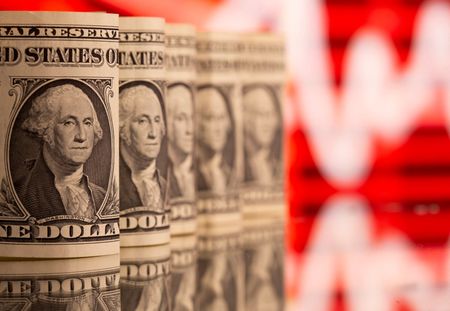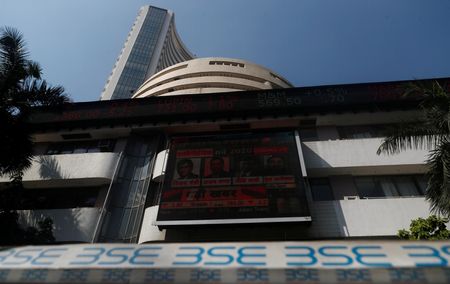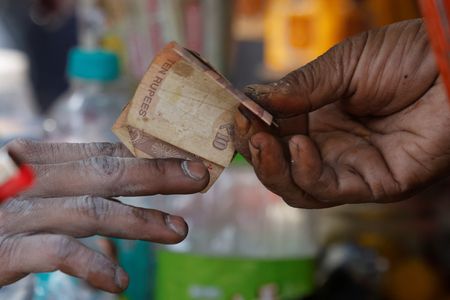By Stefano Rebaudo
(Reuters) – The U.S. dollar was set to snap a three-day rising streak on Tuesday as markets became increasingly numb to U.S. tariff threats while awaiting testimony from Federal Reserve Chair Jerome Powell later in the day and inflation data on Wednesday.
Analysts said the risks of U.S. import duties remained, but there were good reasons to monitor fundamentals.
Powell will deliver his semiannual monetary policy testimony before the Senate Banking, Housing and Urban Affairs Committee at 1500 GMT. U.S. inflation data is due on Wednesday, following strong jobs figures that supported U.S. Treasury yields and the greenback last week.
U.S. President Donald Trump moved to substantially raise tariffs on steel and aluminium imports and said he would announce plans to impose reciprocal tariffs on other countries over the coming days.
Futures priced in around 37 basis points’ worth of Fed rate cuts by the year-end which implies one 25 bps cut and a 48% chance of a second easing move.
Recent comments from Fed officials have underscored their no rush approach to further monetary easing, particularly as they wait for further clarity over how Trump’s policies will affect economic growth and inflation.
The U.S. dollar index — which gauges the dollar’s value relative to a basket of six major currencies — was down 0.1% at 108.28. It rose 0.37% last week, in its biggest daily rise in almost a month, after U.S. jobs data.
“The threat of more U.S. tariffs remains, also against the European Union. Retaliation could even lead to a tail risk scenario of a global trade war,” said Athanasios Vamvakidis, global head of forex research at BofA.
“Even if the worst is avoided, we are concerned that prolonged uncertainty will have negative implications for the global economy,” he added.
The European Union said it would respond with “firm and proportionate countermeasures” after Trump’s decision to impose tariffs on all steel and aluminium imports.
The euro was up 0.15% at $1.0320.
It rose 0.14% at 11.2654 against the Swedish crown after hitting 11.2460, its lowest since September 2024.
It was also up versus the Norway’s crown after hitting the day before 11.6173, its lowest since November.
“The story seems larger than rate differentials, and like its CEE peers, the krona is shaking off the rise in gas prices,” said Chris Turner, head of forex strategy at ING.
“This resilience may be driven by growing optimism about a potential ceasefire deal in Ukraine,” he added.
A White House official confirmed the 25% tariffs on steel and aluminium imports will take effect on March 4.
Analysts said steel and aluminium duties could be based on national security grounds and implemented immediately. However, broad-based reciprocal tariffs will take longer due to required preparatory work.
The U.S. dollar rose 0.15% against the Canadian dollar to C$1.4333, but the loonie was still some distance away from a 22-year low hit earlier this month.
Canada, Brazil, Mexico, South Korea and Vietnam are the biggest sellers of steel into the U.S., according to American Iron and Steel Institute data, while Canada is the dominant supplier of imported aluminium.
The yen was down 0.15% at 152.22 per dollar. It hit 150.93 on Friday, its highest since December 10.
The Japanese currency has been among the best-performers since January’s Bank of Japan meeting, with investors focused on the divergence between real yields in Japan and the U.S.
The Australian dollar rose 0.05% to $0.6271.
Australian Prime Minister Anthony Albanese said on Tuesday Trump has agreed to consider exempting Australia from his steel and aluminium tariffs, in what Albanese called a constructive phone call with the U.S. president.
(Reporting by Stefano Rebaudo; Editing by Bernadette Baum and David Evans)








